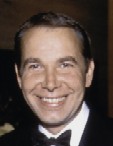
As the inaugural event of Arts & Leisure Week Carol Vogel of the New York Times interviewed contemporary artist Jeff Koons at the Times Center Monday, January 7. Vogel took Koons through a slide show of his work over the years as they discussed how he became the well-known blue chip artist he is today and the various types of artwork he has done over the years. It was a rare opportunity to hear from an artist at the top of his popularity what he considers to be important in art making and what he thinks of his prior work. Recall that in November two consecutive records were set on consecutive days for Koons sculpture at auction. First, Christie’s sold Blue Diamond for $11.8 million and then following night Sotheby’s sold Koons’ red Hanging Heart $23.5 million.
When Vogel asked Koons how he responds to criticism that his work is produced not by the hand of the artist himself but by a team of 80 whom he employs in his studio Koons responded that as an artist it is his responsibility to educate people and to show the public how to look at things. He said that he feels he does that by allocating his time and resources to oversee the art projects in his studio. He later pointed out, while discussing his sculpture of the Great Bear & The Policeman, that he feels a moral obligation to the community that comes with being an artist. Koons said that that sculpture was about how art can get out of control and people can misuse the power of it.
When looking at art and life as a public figure Koons mentioned the Hollywood culture in America. Koons created some billboards as part of a Whitney Museum media based exhibit for a skin film entitled Made in Heaven (a film that was never made) in which Koons collaged himself into a provocative photograph of his wife-to-be Ilona Staller. The billboards were exhibited around New York City. He said that he executed this particular work in order to draw attention to the Hollywood culture and that in order to do so he had to put himself out there for the public to see. In other works, such as Bourgeoise Bust — Jeff & Ilona, Koons explained that he took a personal situation (in this case, his relationship with this then wife) and then used it to participate in American celebrity culture by creating a sculpture for the public showing himself as the protagonist.
Koons enunciated some private reasons for his work as well. Often the inspiration for a work, he said, was his personal cultural history such as imagery from his childhood (the mercury globes in gardens in the area where he grew up inspired his use of reflective materials in his Rabbit, for example) or an object of his grandfather’s (the ashtray that triggered Koons’ Woman in Tub) , etc. Not only was some of the work personally inspired, Koons explained, but often the works become personal for the viewers as, for example, some of the sculptures have reflective surfaces that cause the viewer to be reflected back as if in a mirror when looking at a Koons piece thus creating a personal and active experience for each viewer.
When asked in the Question & Answer session at the end what type of art he likes Koons showed images of Courbet and Manet.
You can see more of Koons’ work this coming summer when he exhibits on the roof of the Metropolitan Museum here in NYC.
